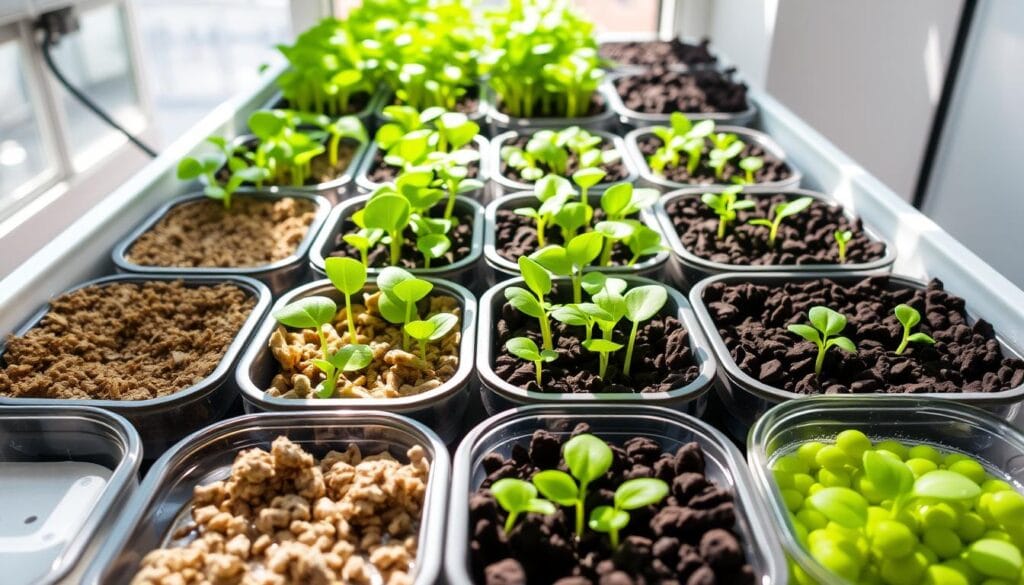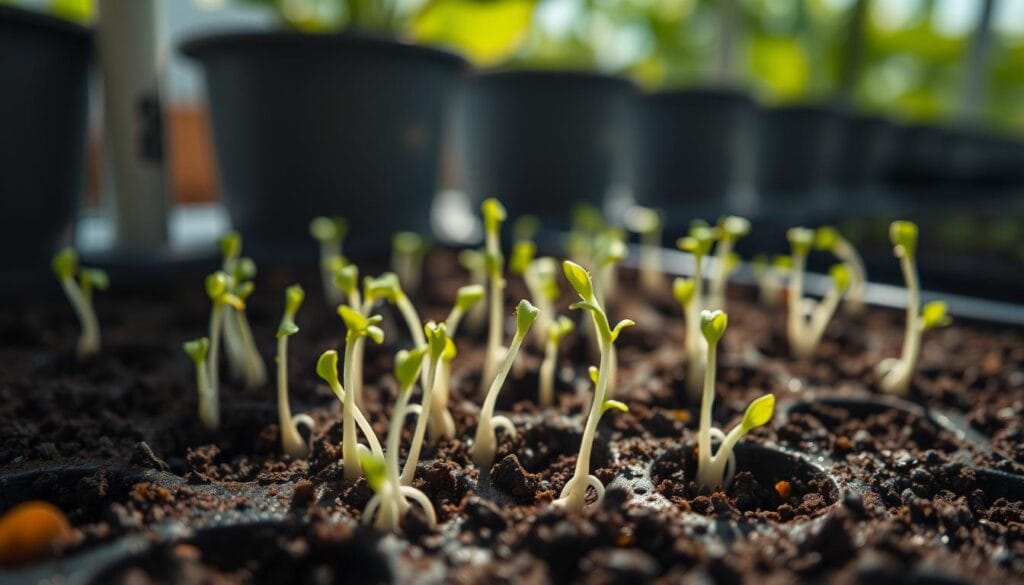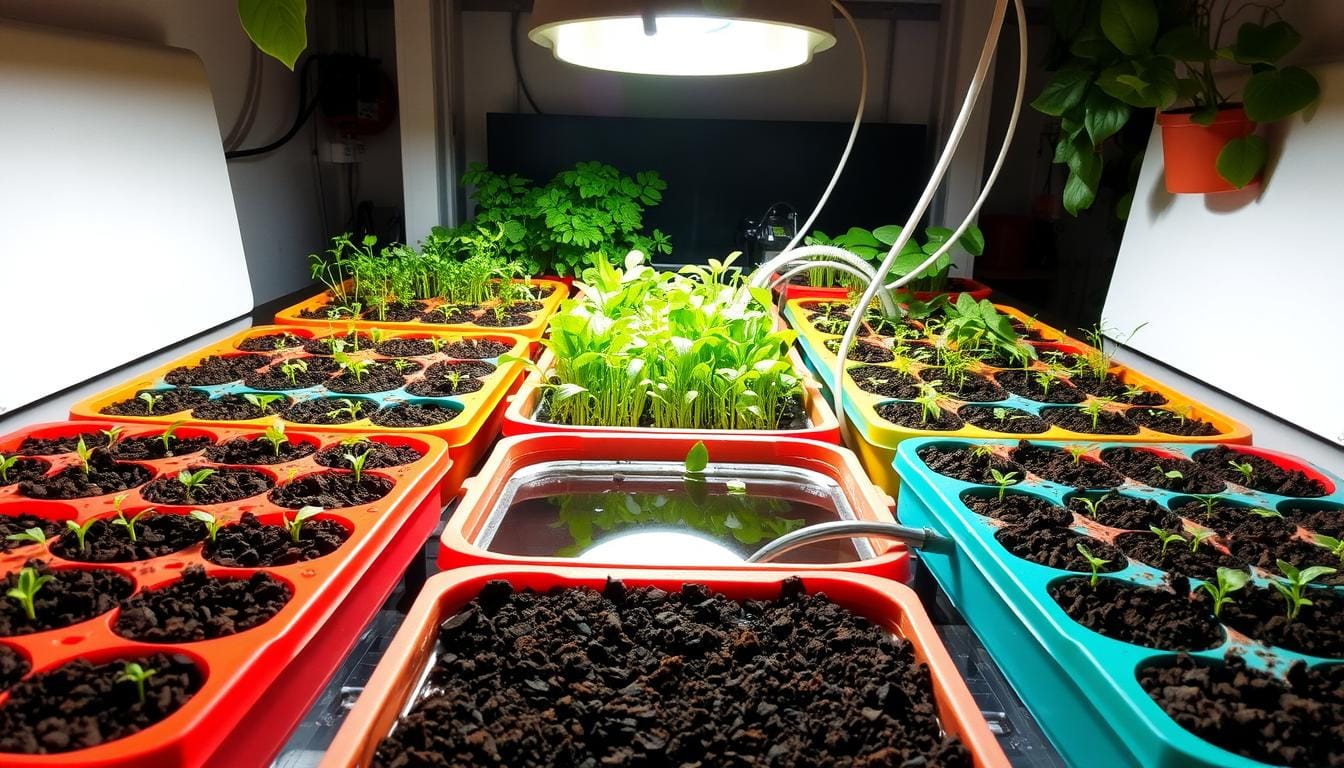Hydroponics opens a new world for growing healthy plants. The seed starting process is key to success. Picking the right hydroponics seed starter is vital for a strong start. This guide will cover the basics, what you need, and tips for germination.
Hydroponics is a soilless way to grow plants, using nutrient-rich water. It can make plants grow faster and healthier than soil. Learning about starting hydroponic seeds can help you get great results in your garden or indoor space.
Key Takeaways
- Hydroponic systems can provide a faster and more efficient method of plant growth compared to soil-based gardening.
- The right hydroponics seed starter is crucial for successful germination and plant development.
- Understanding the essential components and environmental requirements for hydroponic seed starting is key to achieving optimal results.
- Proper nutrient management and monitoring are essential for ensuring the healthy growth of your hydroponic seedlings.
- Avoiding common mistakes in the seed starting process can help you maximize the success of your hydroponic garden.
Understanding Hydroponic Seed Starting Basics
Hydroponics is a new way to start seeds, offering many benefits over old soil methods. It uses water, nutrients, and controlled spaces for faster growth and higher success rates. This method lets you grow seedlings all year round.
Benefits of Hydroponic Seed Starting
Hydroponic seed starting has many advantages:
- Faster germination: Seeds sprout quickly in nutrient-rich water and the right conditions, often in half the time of soil.
- Higher success rates: It avoids soil pests, diseases, and uneven watering, making seedling growth more reliable.
- Year-round growing: You can control temperature, humidity, and light, growing seedlings anytime, no matter the weather.
Essential Components for Success
To get the best results, you need a few key things:
- Water reservoir: A place to hold the nutrient-rich water.
- Nutrient solution: A mix of minerals and nutrients for the seedlings.
- Growing medium: A clean, inert material like rockwool or coco coir for the roots.
- Lighting: Good lighting, like LED grow lights, is vital for seedling growth.
Environmental Requirements
Keeping the right environment is crucial for hydroponics seedlings and seed starting hydroponics. You need to watch temperature, humidity, and pH levels closely. Adjust them to make the best growing space for your seedlings.
| Environmental Factor | Ideal Range |
|---|---|
| Temperature | 70-85°F (21-29°C) |
| Humidity | 60-80% |
| pH | 5.5-6.5 |
By carefully controlling these factors, hydroponic seed starting systems can give your seedlings the best chance to grow.
Types of Seeds for Hydroponic Systems
Choosing the right seeds for hydroponic systems is key to success. There’s a wide range of seeds that do well in these setups. You can grow everything from leafy greens and herbs to certain vegetables.
Lettuce varieties like butterhead, green star, and romaine are great for beginners. They germinate and grow fast. Herbs like basil, cilantro, and parsley also do well, offering fresh flavors.
For those looking to grow more, tomatoes, peppers, and strawberries can thrive in hydroponics. These plants need extra care but can reward you with plenty of fresh produce.
Whether you’re new or experienced, the seed selection for hydroponics is vast and exciting. By choosing the right seeds, you can create a lush hydroponic garden. This garden will give you a steady supply of tasty, healthy crops.
| Seed Type | Total Available | In Stock | Out of Stock |
|---|---|---|---|
| Sprouting Seeds | 34 | 28 | 6 |
| Hot Pepper Seeds | 35 | 25 | 10 |
| Lettuce Seeds | 25 | 20 | 5 |
| Cucumber Seeds | 17 | 12 | 5 |
There are many seeds to choose from for hydroponics. Whether you want fast-growing greens or challenging vegetables, there’s something for everyone. The possibilities are endless when germinating seeds for hydroponics.
Pelleted vs Raw Seeds in Hydroponics
In hydroponics, choosing between pelleted and raw seeds matters a lot. Pelleted seeds have a protective coating that offers many benefits. This makes them a favorite among hydroponic gardeners.
Advantages of Pelleted Seeds
Pelleted seeds germinate better because of their protective coating. This coating shields the seeds from harsh conditions. It leads to more reliable seedling growth, which is great for new growers.
These seeds also make planting more precise. Their larger size helps place them accurately. This can lead to better crop yields and less waste.
When to Use Raw Seeds
Raw seeds are a good choice in some cases. They are cheaper and in their natural state. Some plants do better with raw seeds, especially if they don’t like the pelleting process.
Cost Considerations
Cost is a big factor when picking between pelleted and raw seeds. Pelleted seeds are pricier because of the extra steps in making them. But, their benefits like better germination and precise planting might be worth it. Think about your budget and needs to decide what’s best for you.
| Feature | Pelleted Seeds | Raw Seeds |
|---|---|---|
| Germination Rates | Higher | Lower |
| Planting Precision | Improved | More Challenging |
| Cost | Higher | Lower |
| Shelf Life | Up to 1 year | Variable |
Choosing between pelleted and raw seeds depends on your needs and budget. Look at the pros and cons of each to find the best fit for your hydroponic garden.
Best Growing Mediums for Hydroponics Seed Starter
Choosing the right growing medium is key for hydroponic seeds starting. It ensures successful germination and healthy seedling growth. Various popular choices are available, each offering distinct advantages.
Rockwool is a favorite, known for its water retention and aeration. Rockwool cubes have at least 18% oxygen, which is great for roots. They come in sizes for starting seeds and growing cuttings.
Coco coir comes from coconut husks and is a sustainable choice. It’s fluffy and supports healthy root growth. Its pH stability makes it perfect for seed germination.
Perlite is great for seed germination and early growth. It holds water well and has a porous structure. This ensures good aeration and drainage for seedlings.
- Rockwool: Offers 18%-25% air volume, promoting healthy root growth
- Coco coir: Sustainable, renewable, and pH stable for hydroponic systems
- Perlite: Excellent water-holding capacity, supports seed germination and early growth
When picking a growing medium, think about water retention, aeration, and system compatibility. Making an informed choice will help your hydroponic seed germination journey succeed.

Optimal Temperature and Humidity Levels
Keeping the right temperature and humidity is key for growing hydroponics seedlings. Most seeds like a temperature between 60-75°F (15-24°C) and humidity of 50-70%. Controlling these factors is crucial for your seedlings to thrive.
Managing Climate Control
Use climate control systems like thermostats and humidifiers to manage your setup’s temperature and humidity. Always check these levels and adjust as needed. Different plants may need different conditions, so be ready to adjust your settings.
Monitoring Systems
Set up reliable monitoring systems to track your grow area’s conditions. This could be digital displays, data loggers, or sensors that update in real-time. Regularly checking this data helps spot any issues that need quick action.
Troubleshooting Environmental Issues
If your seedlings seem to be struggling, check the temperature and humidity. Adjust your systems and watch for changes. Being quick to solve problems is important, as small issues can harm your seedlings’ health and growth.
By keeping the temperature and humidity just right, you’ll help your seedlings grow well. Regular monitoring and being flexible are essential for a healthy hydroponics system.
Essential Equipment for Seed Starting
Starting seeds with seed starting hydroponics needs the right tools for success. You’ll need grow trays, water reservoirs, special lights, and monitoring tools. These are key for seed germination and plant growth.
First, get a strong grow tray or table with drainage for your seedlings. A water reservoir keeps the right moisture for your plants. Use high-quality grow lights, like LED or fluorescent, to give your seedlings the light they need.
- An air pump and air stones are important for oxygen in your nutrient solution.
- Mesh pots or net cups are great for holding your growing medium and seedlings.
- A pH meter and EC meter help you check and adjust nutrient levels.
For the best environment, use a timer for lights and a thermometer/hygrometer for temperature and humidity. With these tools, you’re ready for successful seed starting hydroponics.
“Having the right equipment is essential for cultivating healthy hydroponic seedlings. Invest in quality tools to ensure a smooth and productive seed starting journey.”
Creating a controlled environment is crucial for your hydroponic seeds. With the right setup, you’ll see your seeds grow into strong, healthy plants. Enjoy the rewards of your hydroponic garden.
Nutrient Solutions for Seedling Development
For seedlings to grow well in hydroponics, they need a balanced nutrient solution. This solution gives them the essential elements for growth. Let’s explore the key nutrients and how to mix and apply them.
Primary Nutrients
The primary nutrients for plant growth are nitrogen (N), phosphorus (P), and potassium (K). They are vital for photosynthesis, root growth, and plant strength.
Secondary Nutrients
Seedlings also need calcium, magnesium, and sulfur. These help with cell walls, enzyme work, and making chlorophyll, even if in smaller amounts.
Mixing and Application Guidelines
When making your nutrient solution, follow the instructions closely. Start with a weaker solution for young seedlings and increase it as they grow. Check and adjust the nutrients often, changing the solution every two weeks to keep your seedlings healthy.
Good nutrient management is key for growing strong hydroponic seedlings. Knowing about primary and secondary nutrients and following the mixing and application guidelines will help your plants grow well and produce a lot.
| Nutrient | Function | Recommended Concentration |
|---|---|---|
| Nitrogen (N) | Promotes vegetative growth, chlorophyll production | 150 ppm |
| Phosphorus (P) | Supports root development, flowering, and fruiting | 31 ppm |
| Potassium (K) | Improves overall plant vigor, disease resistance, and water regulation | 210 ppm |
| Calcium (Ca) | Strengthens cell walls and aids in nutrient transport | 150 ppm |
| Magnesium (Mg) | Essential for chlorophyll production and enzyme activation | 50 ppm |
| Sulfur (S) | Contributes to protein synthesis and root growth | 32 ppm |
The table shows a typical recipe for hydroponic herbs. But, the exact amounts might change based on the plant, its stage, and the system’s needs. Always check the hydroponics seed starter system’s guidelines for the best nutrient mix.
“Providing the right nutrient solutions is crucial for the healthy development of your hydroponic seedlings. By following the recommended guidelines, you can ensure your plants thrive and reach their full potential.”
Common Mistakes to Avoid in Seed Starting
Starting seeds for hydroponics can be tricky. Avoiding common mistakes is key to success. Mistakes like overwatering, wrong lighting, bad nutrient levels, and poor pH can ruin your start. Let’s look at the main mistakes to avoid.
Using tap water with high minerals is a big no-no. It can harm seedling growth. Use purified or distilled water instead. Also, make sure the nutrient solution has the right balance of nutrients for your seedlings.
Light in the nutrient solution can cause algae. Keep the area away from direct light. Good air circulation is also vital to prevent diseases like damping-off.
- Don’t overwater your hydroponic seedlings to avoid root rot.
- Make sure the growing medium is well-aerated and drains well to prevent waterlogging.
- Be careful when transplanting to not hurt the seedlings’ roots.
- Keep an eye on temperature and humidity to ensure the best conditions for seedling growth.
Avoiding these mistakes can help your germinating seeds for hydroponics succeed. With careful attention and a proactive mindset, you can build a thriving hydroponic garden.
| Mistake | Consequence | Solution |
|---|---|---|
| Overwatering | Root rot, stunted growth | Adjust watering schedule, ensure proper drainage |
| Improper lighting | Algae growth, etiolation | Provide adequate, consistent lighting; shield from direct light |
| Incorrect nutrient concentrations | Nutrient deficiencies or toxicities | Monitor and adjust nutrient solution as needed |
| Poor pH management | Nutrient lockout, stunted growth | Maintain optimal pH range for hydroponics |

By being careful and avoiding these mistakes, you’ll have a great start with germinating seeds for hydroponics and a healthy hydroponic garden.
Maintenance and Monitoring Techniques
Keeping your hydroponics seedlings healthy is key to their growth. By using these important methods, your garden will flourish.
Regulating pH and Nutrient Levels
Always check your pH levels, aiming for 5.5 to 6.0 for most plants. Use pH up or down solutions as needed. Also, keep an eye on nutrient solution levels and refill when needed.
Sanitizing and Cleaning Equipment
Clean and sanitize your hydroponics gear often. This stops diseases and algae. Sterilize containers, tubing, and other parts touching your plants.
Inspecting Seedlings Daily
Every day, check your seedlings for stress, nutrient needs, or pests. Fix problems quickly to keep your plants healthy.
Maintaining Optimal Environmental Conditions
Make sure your setup has good air flow, temperature, and light. Adjust these as your seedlings grow for the best environment.
| Maintenance Task | Frequency | Importance |
|---|---|---|
| pH Testing and Adjustment | Daily | Crucial for nutrient absorption and plant health |
| Nutrient Solution Monitoring | Every 2-3 Days | Ensures balanced nutrition for optimal growth |
| Equipment Cleaning and Sanitation | Weekly | Prevents disease and algae buildup |
| Seedling Inspection | Daily | Identifies and addresses issues early |
| Environmental Adjustments | As Needed | Provides the ideal growing conditions |
Regular maintenance and monitoring are vital for your hydroponics seedlings. Stay alert, and your garden will flourish.
Conclusion
Hydroponic seed starting is great for both indoor gardeners and commercial growers. It helps you grow healthy plants from seeds. You need to pick the right seeds and use the best equipment and growing mediums.
Keeping the environment just right is also key. This way, your hydroponic system will do well.
This guide has shown you the good things about starting seeds hydroponically. You can grow more food with less resources and help the planet. By watching your system and making changes, you can get even better at growing plants indoors.
Hydroponics lets you grow many different plants indoors. Create a self-sustaining garden that thrives with minimal upkeep. It’s a great way to grow your food.
With the right steps and hard work, you can make hydroponic seed starting work for you. You’ll get a lot of food that’s full of nutrients. Start your hydroponic adventure and see how it changes your gardening.

